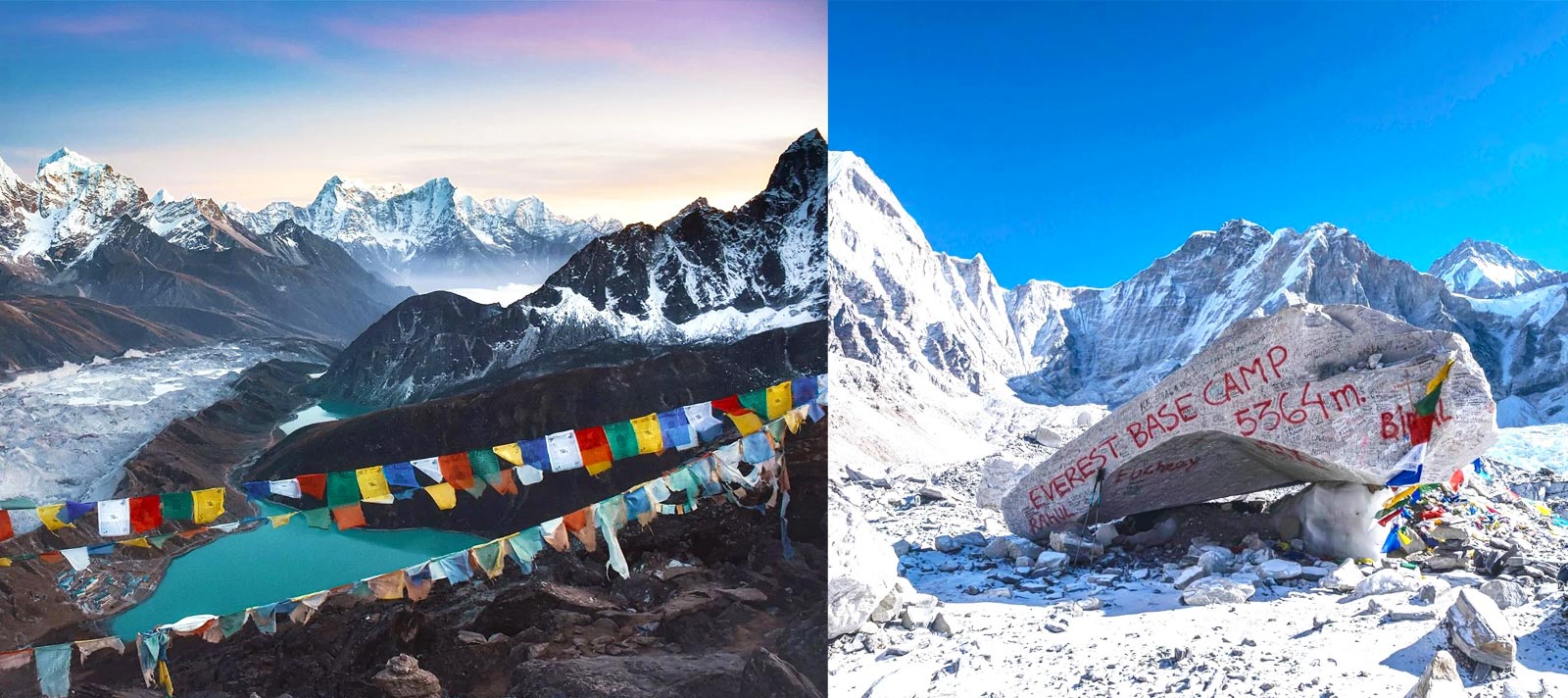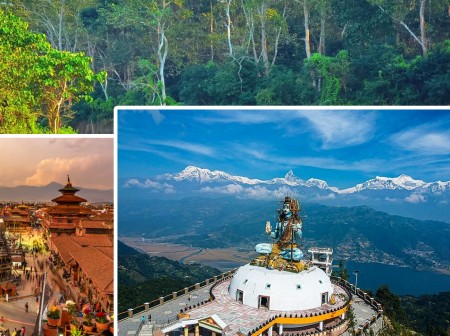
Gokyo Valley vs Everest Base Camp Trek
- soleencounters
When it comes to trekking in Nepal’s Everest region, two iconic routes stand out: the Everest Base Camp Trek and the Gokyo Valley Trek. Both offer breathtaking scenery, cultural immersion, and unforgettable Himalayan adventures—but they are quite different in terms of experience, highlights, and atmosphere.
Table of Contents
If you’re wondering which trek is right for you, this guide provides a clear comparison between the two. With insights from our team at Sole Encounters Trekking Pvt. Ltd., we’ll explore their routes, costs, difficulty levels, cultural encounters, and best seasons to help you make the best decision.
For full details on the Gokyo route, see our package here: Gokyo Valley Trek Nepal.
Key Differences at a Glance
Both treks are located in the Everest region, but their experiences vary greatly.
-
Everest Base Camp Trek (EBC): Famous for reaching the foot of the world’s highest mountain. A busy, bucket-list trek offering iconic views and bustling trails.
-
Gokyo Valley Trek: A quieter alternative featuring sacred turquoise lakes, the Ngozumpa Glacier, and the panoramic viewpoint of Gokyo Ri.
Let’s explore these differences in detail.
Route and Scenery
Everest Base Camp Trek
The classic Everest Base Camp Trek takes you from Lukla through Namche Bazaar, Tengboche, Dingboche, Lobuche, and finally to Everest Base Camp at 5,364 meters. Along the way, trekkers pass through Sherpa villages, monasteries, and rhododendron forests, with Everest always in sight.
Highlights include:
-
Standing at the base of Mount Everest.
-
Climbing Kala Patthar (5,545m) for sunrise views of Everest.
-
Experiencing vibrant Sherpa culture in Namche Bazaar and Tengboche.
Gokyo Valley Trek
The Gokyo Valley Trek diverges from the main EBC trail at Namche and leads toward the high-altitude lakes of Gokyo. Trekkers walk alongside the Ngozumpa Glacier, visit six turquoise lakes, and climb Gokyo Ri (5,357m) for sweeping Himalayan panoramas.
Highlights include:
-
The breathtaking Gokyo Lakes, sacred to both Hindus and Buddhists.
-
The longest glacier in Nepal.
-
A quieter, more peaceful trekking experience with equally dramatic views of Everest, Lhotse, Makalu, and Cho Oyu.
Difficulty and Duration
-
Everest Base Camp Trek: Usually 12–14 days, with long daily walks at high altitude. The final push to EBC can be strenuous.
-
Gokyo Valley Trek: Also around 12–14 days, but the ascents are more gradual, making it slightly easier on the body while still requiring good fitness.
If you want to challenge yourself by standing at the base of Everest, EBC is the trek for you. If you prefer a less crowded route with a gentler pace, the Gokyo Valley may be better.
Best Viewpoints
-
Kala Patthar (EBC): Famous for close-up sunrise views of Everest.
-
Gokyo Ri (Gokyo Valley): Offers a broader panorama, capturing Everest along with Lhotse, Cho Oyu, and Makalu—the world’s four tallest peaks together.
Many trekkers consider Gokyo Ri one of the finest viewpoints in Nepal.
Culture and Atmosphere
-
Everest Base Camp Trek: The route is busy, with well-established teahouses, bakeries, and a more commercial feel. It offers vibrant social energy with trekkers from around the world.
-
Gokyo Valley Trek: Villages are quieter and less commercialized, allowing for more authentic cultural encounters with the Sherpa people.
Costs and Logistics
Both treks cost roughly the same, with packages averaging USD 1,200–1,600 depending on inclusions. The main expenses include Lukla flights, accommodation, meals, guides, porters, and permits.
Permits required for both treks are:
-
Sagarmatha National Park Entry Permit
-
Khumbu Pasang Lhamu Rural Municipality Permit
For transparent pricing and complete service, explore our Gokyo Valley Trek Nepal package or check our Everest region trekking options on the Sole Encounters website.
Best Time to Trek
Both treks share the same best trekking seasons:
-
Spring (March–May): Warm days, rhododendron blooms, and clear skies.
-
Autumn (September–November): Stable weather and excellent mountain views.
-
Winter (December–February): Trekking is possible but colder, especially above 4,500 meters.
-
Monsoon (June–August): Not recommended due to heavy rainfall and poor visibility.
If photography and clear skies are your priority, autumn is the best. For fewer crowds and colorful landscapes, choose spring.
Who Should Choose Which Trek?
-
Choose Everest Base Camp Trek if:
-
Standing at the base of Everest is your ultimate goal.
-
You want to follow one of the world’s most famous trekking routes.
-
You don’t mind busier trails and teahouses.
-
-
Choose Gokyo Valley Trek if:
-
You prefer quieter trails with fewer trekkers.
-
You want to explore the beautiful Gokyo Lakes and climb Gokyo Ri.
-
You’re looking for dramatic mountain views without the heavy crowds.
-
Some adventurers even combine both by crossing the Cho La Pass, linking Gokyo Valley with Everest Base Camp for a longer, more challenging trek.
Why Trek with Sole Encounters Trekking?
At Sole Encounters Trekking Pvt. Ltd., we specialize in crafting safe, memorable, and authentic Himalayan journeys. When you book with us, you enjoy:
-
Experienced Sherpa guides with local knowledge.
-
Tailor-made itineraries for both Gokyo Valley and Everest Base Camp.
-
Full logistical support including permits, flights, and accommodation.
-
Ethical trekking practices that support local communities.
Check our detailed itinerary here: Gokyo Valley Trek Nepal or talk directly to our experts for advice on which trek suits you best.
Conclusion
Both the Gokyo Valley Trek and the Everest Base Camp Trek are world-class adventures in the Everest region. Choosing between them depends on your priorities: if your dream is to stand at the base of Mount Everest, the classic EBC route is for you. If you want a more peaceful trek with equally breathtaking views, sacred lakes, and authentic cultural experiences, the Gokyo Valley is the better choice.
Whichever path you take, trekking in Nepal’s Himalayas is an experience you will cherish for a lifetime. For planning, pricing, and expert guidance, visit our Contact Us page or speak with our trekking team.
Recent Posts
.jpg)
3rd Jul, 2025
.jpg)
4th Jul, 2025
.jpg)
4th Jul, 2025
.jpg)
7th Jul, 2025
.jpg)
8th Jul, 2025
.jpg)
8th Jul, 2025
.jpg)
8th Jul, 2025

10th Jul, 2025








